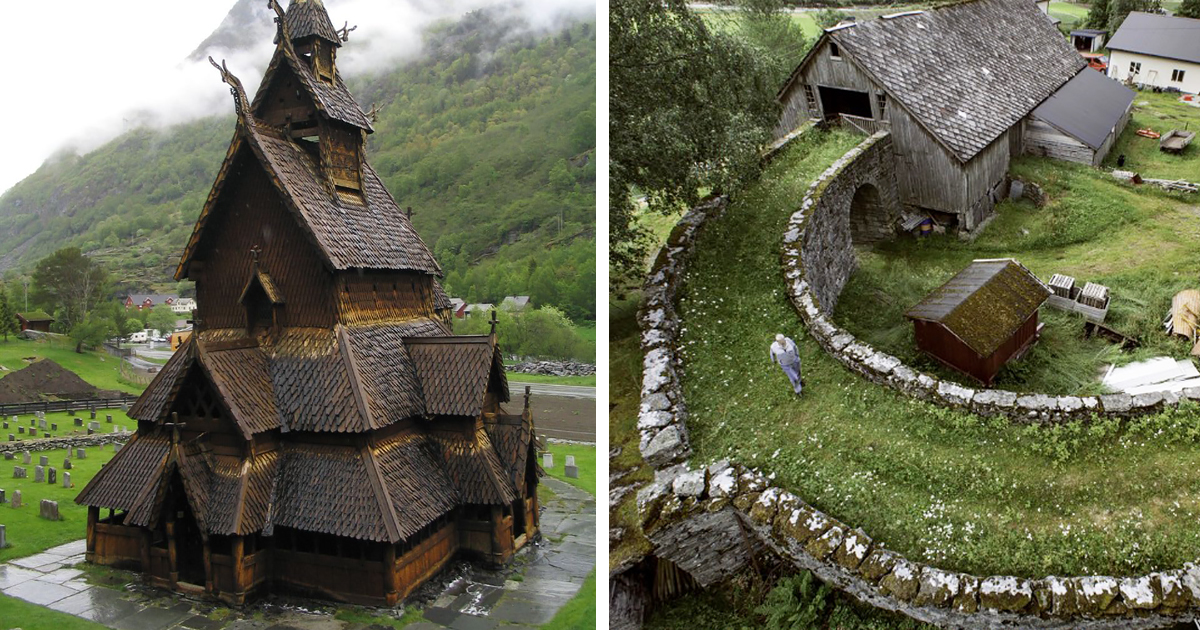 Architecture
Architecture
Due to the large forest resources in Norway, wood has long been the main building material in the country. Because the use of wood requires less work (and it is less expensive) than cutting out, treatment and erection of stone walls, farmers, farmers and fishermen put them down cozy, small, wooden houses. Meanwhile, the richer ones showed off their wealth, erecting sumptuous, but cold and drafty stone houses. In the Far North, where and stone, and the wood is rather lacking, The Sarns were building turf huts, which was in abundance and which provides excellent protection against the cold.
Most large religious objects, which were built of stone, shows Anglo-Saxon influence; notable exceptions are the cathedral of Nidaros (medieval name of Trondheim) in the Gothic style and the Romanesque cathedral in Stavanger. There is nothing strange about this, considering, that Christianity came to Norway from England. However, churches dating from the end of the Viking Age and the early Middle Ages were built of ornately carved wood. To, which have survived to this day, have undergone numerous changes. The unique stavkyrke are among the oldest surviving wooden candle-lit buildings. Their name comes from the vertical load-bearing columns used in the construction. Stave churches are distinguished by intricately carved motifs, tops topped with dragons, resembling the bows of classic Viking boats, and undeniably beautiful, resembling oriental, form. FROM 500 – 600 temples only approx. 20 preserved in its original condition, and in the rest, only some original parts have survived.
After the plague epidemic in the mid-fourteenth century, the country passed into the hands of Denmark (1380 r.). For almost four centuries, the architecture reflected the traditions of the European Renaissance and Baroque, which ruled Denmark and Germany at that time. These trends remained alive even after the union with Denmark was dissolved (1814 r.). After the fire of the mainly wooden city of Oslo (1624 r.) king Christian IV decided, that to reduce the risk of fire in the future, the whole city will be rebuilt in brick, and the streets will be wide. W XIX w. there was a need to build larger public buildings in the capital. This coincided with the emergence of a new architectural style in Europe – empire – which added splendor to the royal palace in Oslo, University, the stock exchange, Norwegian Bank, Christiania theater and other public buildings.
More or less in the mid-nineteenth century. Norwegian architects began to travel regularly to Italy in search of inspiration. On the way, they discovered the "gingerbread house"” wooden architecture, characteristic of the Alpine region. The association was self-evident: this style could be applied in wood-rich Norway. Hence, the northern country was swarmed with wooden spa hotels, decorated with Norwegian motifs, which eventually became famous as examples of the Norwegian "dragon style."”. Many buildings did not survive the test of time and burned down, some antique ones though, Hotels in this style have been preserved throughout the country to this day.
At the beginning of the 20th century. the architect Henrik Buli introduced fugendstil in Norway (the German equivalent of Art Nouveau or Art Nouveau). The buildings of the Ministry of Finance are examples of the use of this style, National Theater and Historical Museum in Oslo, and tenement houses in the city of Alesund, completely rebuilt after the fire in 1904 r., which devastated the entire city.
After the destruction 11 During World War II, Norway faced the task of rebuilding towns and settlements in the north of the country. Under the influence of the ruling Norwegian Labor Party, Norwegian architecture took a turn towards, which best sums up the slogan of the time: "a roof over the head”. The style referred to those flowing from the USSR, preaching views that are so well known to us, that the apartments should be functional, but they are the same for everyone and do not stand out from the crowd. Practical apartment blocks and uninteresting commercial and public buildings began to emerge across the country. Certain cities, such as Mo i Rana and Honningsv3g, it lacks charm. Fortunately in the years 80. with prosperity, postmodernism has appeared and most of the new buildings are original.
